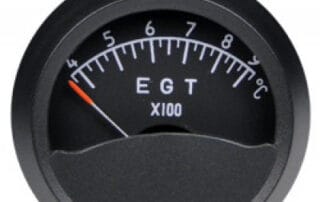EGT Myths Debunked
Reprinted with permission from the author, Mike Busch
Pilots still seem to have a lot of misconceptions about exhaust gas temperature (EGT). Let’s see if we can clear some of them up.
These days, pilots of piston-powered aircraft seem to have fixated upon EGT. Scarcely a day goes by that I don’t receive a phone call, email, or support ticket asking some EGT-related question.
Pilots will send me a list of EGT readings for each of their cylinders and ask me if think they look okay, whether I think their EGTs are too high, what maximum EGT limit I recommend, why their EGTs seem to be higher in the winter than in the summer, or why the EGTs on their 1972 Cessna 182 are so much higher than the ones on their friend’s 1977 model. They’ll voice concern that the individual cylinders on their engine have such diverse EGT readings, worry that the spread between the highest and lowest EGT is excessive, and ask for advice on how to bring them closer together. They’ll complain that they are unable to transition from rich-of-peak (ROP) to lean-of-peak (LOP) operation without producing EGTs that are unacceptably high.
Each of these questions reveals a fundamental misunderstanding of what EGT measures, what it means, and how it is interpreted. Let me attempt to clear up some of this confusion by asking you to forget everything you thought you knew about EGT and start at the beginning.
What EGT is not
The absolute values of EGT are not particularly interesting for a number of reasons. The most important is that indicated EGT is not a “real” temperature. To understand what I mean by this, I’d like you to conduct a thought experiment: Imagine that you’re an EGT probe, located in an exhaust riser between two and four inches from the exhaust port of a cylinders, and think about what you would see.
You’d see nothing much for two-thirds of the time¾during most of the intake, compression, and power strokes, because the exhaust valve is closed and so no exhaust gas is flowing out of the exhaust port and past the probe. During the one-third of the time that the exhaust valve is open, you’d see a constantly changing gas temperature that starts out very hot when the valve first opens but cools very rapidly as the hot compressed gas escapes and expands, and then ultimately is scavenged by cold induction air during the valve overlap period (at the end of the exhaust stroke and the beginning of the intake stroke) when both intake and exhaust valves are open simultaneously.
Now, all these gyrations are happening about 20 times per second, and you (the EGT probe) cannot possibly keep up with them. You wind up stabilizing at some temperature between the hottest and coolest gas temperature you see, and you dutifully report this rather arbitrary temperature to the panel-mounted instrument, where it is displayed to the pilot as a digital value accurate to one degree. The temperature you report to the pilot is not exhaust gas temperature (which is gyrating crazily 20 times a second) but rather exhaust probe temperature (which is stable but related to actual exhaust gas temperature in roughly the same fashion as mean sea level is to high tide).
To make matters worse, numerous factors can affect indicated EGT besides actual exhaust gas temperature. These include probe mass and construction (grounded or ungrounded), cam lobe profile, lifter leak-down rate, valve spring condition, and exhaust manifold topology, among others.
For example, the two front cylinders (numbers 5 and 6) on the left engine of my Cessna T310R always indicate lower EGTs than the other four cylinders. The exact same phenomenon also occurs on the right engine. This is not because those front cylinders produce cooler exhaust gas than their neighbors (they don’t), but because the exhaust risers for those cylinders curve aft while the other four risers go straight down. Thus, the gas flow past the EGT probe is different for the front cylinders than for the others, and their indicated EGT is lower. This temperature anomaly is quite obvious on my digital engine monitor¾and also quite meaningless.
What EGT means
Even if indicated EGT accurately reported actual exhaust gas temperature (which it doesn’t), it’s important to understand that exhaust gas temperature does not correlate with stress on the engine the way cylinder head temperature does. In fact, many things that increase engine stress (such as advanced ignition timing and high compression ratio) cause EGT to go down, while things that reduce engine stress (like retarded ignition timing and low compression ratio) cause EGT to go up.
Remember that CHT mainly reflects what’s going on in the cylinders during the power stroke when the cylinder is under maximum stress from high internal temperatures and pressures, while EGT mainly reflects what’s going on during the exhaust stroke after the exhaust valve opens and the cylinder is under relatively low stress.
High CHTs often indicate that the engine is under excessive stress, which is why it’s so important to limit CHTs to a tolerable value (no more than 400°, preferably 380° or less). By contrast, high EGTs do not indicate that the engine is under excessive stress, but simply that a lot of energy from the fuel is being wasted out the exhaust pipe rather than being extracted in the form of mechanical energy.
For instance, a 1972 Cessna 182 with an O-470-R engine will typically have indicated EGTs that are 100 degrees hotter than those seen in a 1977 Cessna 812 with an O-470-U engine. The -R has a relatively low 7.0–1 compression ratio because it was certificated for 80-octane avgas, while the -U engine has a much higher 8.6–1 compression ratio because it was certificated for 100-octane. Because the high-compression -U engine is significantly more efficient at extracting heat energy from the fuel, it wastes less energy out the exhaust and this its EGTs are cooler (despite the fact that the -U engine is much more highly stressed than the -R).
High EGTs do not represent a threat to cylinder longevity the way high CHTs do. Therefore, limiting EGTs in an attempt to be “kind to the engine” is simply misguided.
Diff versus Gami spread
Right behind the “high EGTs are bad” myth is the “identical EGTs are good” myth. Many pilots believe incorrectly that a flat-topped graphic engine monitor display (with all EGTs equal) is the mark of a well-balanced engine, and that unequal EGTs are a sign that something is wrong. This common misconception tends to be reinforced by digital engine monitors that display a digital “DIFF” showing the difference between the highest and lowest EGT indication.
As illustrated by the earlier anecdote about the front cylinders on my Cessna 310R, difference between absolute EGT values are both normal and benign. It is not uncommon for well-balanced fuel-injected engines to exhibit EGT spreads of 100 degrees, and carbureted engines often have spreads of 150 degrees or more. In fact, as shown in Figure 4, EGT spreads are usually smallest near or just rich of peak EGT (the worst place to operate the engine), and often significantly greater at leaner or richer mixture (that are much kinder to the engine.
The mark of a well-balanced engine is not a small EGT spread (“DIFF”), but rather a small “GAMI spread”– defined as the difference in fuel flows at which the various cylinders reach peak EGT. Ideally, we would like to see this peak be no more than about 0.5 gph (or 3 pph). Experience shows that if the GAMI spread is much more than that, the engine is unlikely to run smoothly with LOP mixtures.
It’s all relative
The only important thing about EGT is its relative value: how far below peak EGT and in which direction (e.g., 100 degrees ROP or 50 degrees LOP). Absolute values of EGT (e.g., 1,475 degrees) are simply not meaningful and are best ignored. There is no such thing as a maximum EGT limit or redline, and trying to keep absolute EGTs below some particular value¾or even worse, leaning to a particular absolute EGT value¾is simply wrongheaded. Don’t do it. If you must fixate on those digital engine monitor readouts, fixate on something important, like CHT.




